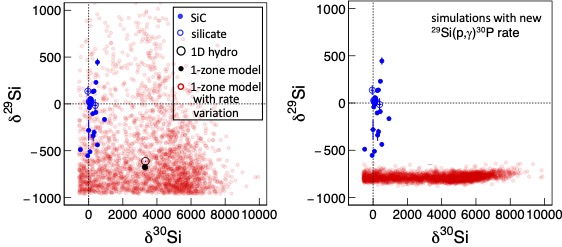Presolar stardust grains found in primitive meteorites are believed to retain the isotopic composition of stellar outflows at the time of grain condensation. Therefore, laboratory measurements of their isotopic ratios represent sensitive probes for investigating open questions related to stellar evolution, stellar explosions, nucleosynthesis, mixing mechanisms, dust formation, and galactic chemical evolution. For a few selected presolar grains, classical novae have been discussed as a potential source. For SiC, silicate, and graphite presolar grains, the association is based on the observation of small N(12C)/N(13C) and N(14N)/N(15N) number abundance ratios compared to solar values, and abundance excesses in 30Si relative to 29Si, as previously predicted by models of classical novae. However, these simulations have entirely disregarded the large uncertainties in the 29Si(p, gamma)30P thermonuclear rate. When the uncertainties are taken into account, the simulated silicon isotopic ratio values reveal a significant scatter, as shown in the left panel, preventing any conclusion regarding the nova paternity of measured presolar grains. We measured this reaction directly at the local Laboratory for Experimental Nuclear Astrophysics (LENA). The significance of this measurement is demonstrated by comparing the left panel (before our experiment) to the right one (after). The scatter in the 29Si/28Si ratio (i.e., on the y-axis) is dramatically improved. Our results establish, for the first time, 29Si/28Si values measured in presolar grains as a sensitive probe for assessing their classical nova paternity. This work has been published in Downen et al., The Astrophysical Journal 928, 128 (2022).
Stardust from Stellar Explosions
Comments are closed.


